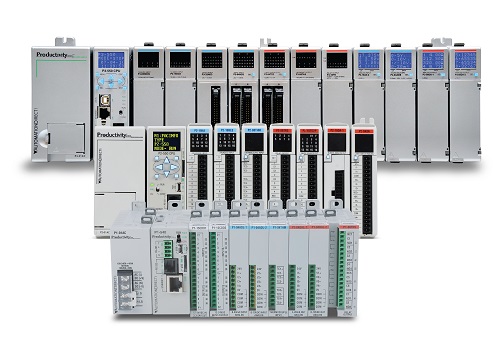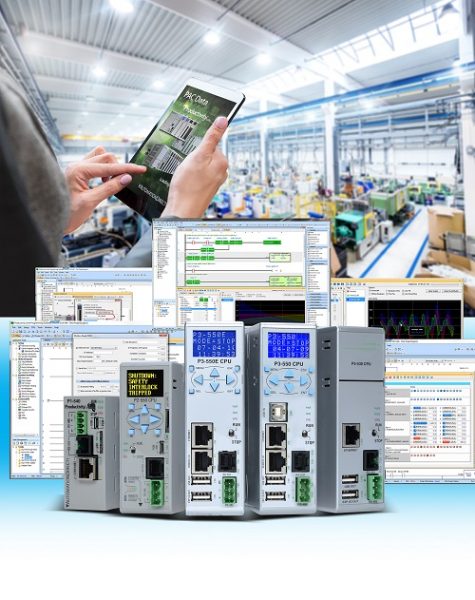Choosing the most effective controller requires careful evaluation of multiple requirements.
Jeff Payne, Automation Controls Group Product Manager at AutomationDirect, wrote an article appearing in the August 2018 issue of Applied Automation titled How to Choose an Industrial Automation Controller.
There are many important items to consider when choosing a controller for machine and process automation, says Payne.
Breaking down the equipment’s operational needs is a starting point and will help evaluate the range of controllers specified by OEMs or machine builders. Depending on how the equipment fits into the larger manufacturing environment, the automation system can provide a complete solution or just control individual parts.
 The specified controller, such as a PLC or PAC, can control a single station, a machine, a process unit, a whole assembly line or an entire plant. If an integrated manufacturing system is being automated, a single large controller using multiple expansion and remote I/O bases communicating via Ethernet can provide end-to-end control.
The specified controller, such as a PLC or PAC, can control a single station, a machine, a process unit, a whole assembly line or an entire plant. If an integrated manufacturing system is being automated, a single large controller using multiple expansion and remote I/O bases communicating via Ethernet can provide end-to-end control.
In this block diagram, each module is a machine that can be controlled separately by a smaller PLC, or together by a larger PLC.
Some controller families, such as AutomationDirect’s Productivity Series PLCs, offer several different options, each using the same programming software. The single programming environment provides application flexibility while saving time and money because programs can easily be converted or moved from one PLC to another for compatibility among projects.
These AutomationDirect Productivity Series 1000, 2000 and 3000 PLCs are different size controllers, but each uses the same programming software.
Payne says the difficult part can be deciding whether to run a single program on a large PLC, or to deploy the same project on multiple smaller PLCs.
To help decide which is the best controller to use in your application, the Table provides a list of factors to consider.
Factors to Consider When Choosing a Controller
- Automating new or existing system
- Environmental issues
- Discrete devices
- Analog devices
- Loop control
- Specialty modules or features
- I/O locations (local and remote)
- Communication
- Programming
Whether the system is new or existing often dictates many of the critical factors for selection. If there are products already installed, it’s a good practice to make the new system compatible with them. Some controller products are not compatible with others, even from the same manufacturer.
Number, Types and Location of I/O
It is good practice to list all the discrete inputs and outputs on a spreadsheet—and to define each type such as sensor, sensor, solenoid, actuator, control valve and so on. Include the signal type, power requirement, communication protocol and other considerations.
The number of I/O points and types defined has a big effect on the control platform selected. A common mistake is to select a controller able to handle immediate needs but without room for future expansion. Including room to accommodate an extra 20 percent I/O can prevent major difficulties down the road.
The physical location of the I/O terminals with respect to the field devices should also be carefully defined and added to the spreadsheet. This modular breakdown will help lay out the local and remote I/O needs, and what real-time communication protocols may be required. Some installations keep things local, whereas others rely heavily on remote I/O, and some use a combination of both.
It’s Time to Communicate
In addition to distributed I/O, communication among multiple PLCs, peripheral devices and enterprise-level systems may be required, Payne notes.
Communication to other systems, HMIs and field devices via industrial Ethernet or serial communication needs to be defined. With the rapid growth of Internet of Things applications, more comm ports and communication options are always better. Make sure there are one or two extra Ethernet ports, a serial port, a USB port and other configurable options available.
AutomationDirect Productivity Series CPUs offer the ability to communicate via industrial Ethernet, serial and USB connections.
 Specify which Ethernet protocols—such as EtherNet/IP or Modbus TCP, along with serial and ASCII protocols—are needed. This will help when selecting a controller able to support current and future requirements.
Specify which Ethernet protocols—such as EtherNet/IP or Modbus TCP, along with serial and ASCII protocols—are needed. This will help when selecting a controller able to support current and future requirements.
Hardware Requirements
Some hardware requirements to consider are the amount of memory, scan-time speed and battery backup. The controller will need sufficient system memory to support both data and program requirements.
The need to store historical data in the controller can call for a much larger data table size. Careful detail of data logging requirements, access methods to get to the data, and interfaces to HMI/SCADA and historian databases should be specified. Networking, protocol and the memory needs are all import requirements for connection to the Industrial Internet of Things.
Different program instructions have different memory needs, usually noted in the programming manual. A useful rule of thumb suggests five to 100 words of memory for each discrete I/O device, and 25 to 500 words of memory for analog I/O. A better way is to develop some preliminary code for a portion of the application and check actual memory usage.
Software Requirements
While the software platform and programing methods are often a matter of personal choice, functional requirements are not. The availability of PID loops, floating-point math, drum sequencing, program interrupts and subroutines must be considered in the selection process. The number of PID loops required is often underestimated, so the application and controller support should both be checked. Look carefully at all programming functions required.
Many other factors may enter into the discussion, but performing a thorough analysis of the points presented here will be a good start to selecting the right controller for your application.
To read more articles about programmable control, click here.
Originally Published: August 2018


